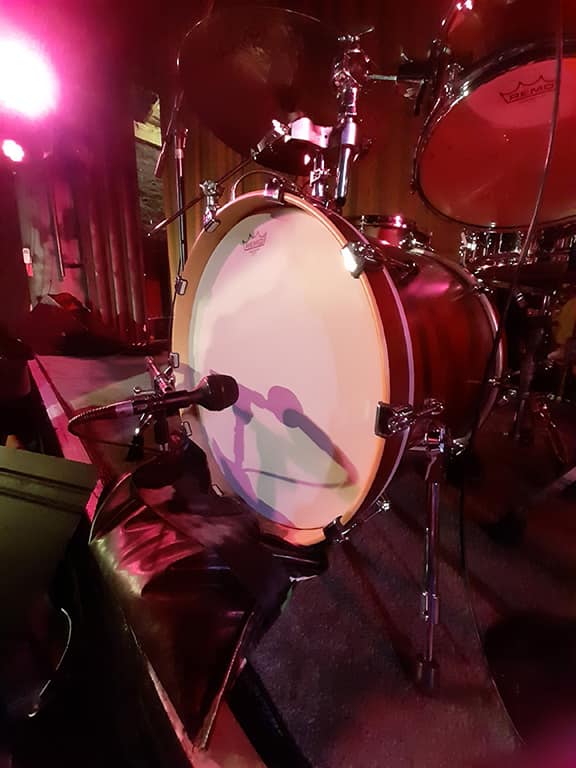
Review: DPA 4055 Kick Drum Microphone
A new DPA mic is always newsworthy. Woodsy discovers just what its new kick drum mic is made of.
Accuracy through precision is what DPA (Danish Professional Audio) is about. It’s the DNA coming through from its Bruel & Kjaer (B&K) roots, which had been developing measurement microphones since the 1950s and had some success in the 1980s with mics aimed more at musical sources.
I met them when a sales rep gave me a pair of Series 4000 professional microphones to try on a US tour with Tina Turner in 1985 — best overheads I’d ever used. For Australian readers, enigmatic singer Stephen Cummings album ‘Lovetown’ was recorded with one B&K 4007 omni, it was the only good mic I had at the time. That was 1988, I recall Stephen recording the vocals curled up on the floor of the vocal booth cradling the 4007. The album sounds good and I’ve always credited the B&K mic.
In the early 1990s Ole Brøsted Sørensen and Morten Støve left B&K and started DPA to focus on pro audio products and it seems to have worked out well for both companies. One of DPA’s first releases, the 4006 omni, was directly adapted from an original B&K measurement mic and remains one of the world’s favourite recording mics, renowned for its clarity and transparency.
Currently best known at live shows for their DPA 4099 super-cardioid clip-on condenser mics, generally regarded as the best available for many acoustic instruments, especially strings, I’m also seeing more singers using the newer DPA d:facto 4018 handheld condenser. Both of these are premium quality and professionally priced microphones — soon to be joined on stage by the exciting new DPA 4055 kick drum microphone. A thoroughly modern design, it accepts and challenges some of the preconceptions and expectations for a kick mic while inviting the important question – what makes a great kick mic?
IN THE BEGINNING…
In the beginning there was the AKG D12, released in 1953 as the world’s first unidirectional microphone. Designed for vocals mic with a bass chamber in the rear compartment to give a fuller sound, it had a strong, wooly response below 100Hz with a big proximity effect. Originally used as voice mics for radio and TV but with the rise of rock bands and 1970s PAs, with all those W-bins, the thick response up close and high level handling made them a natural for kick drums. The big square body also looked the part… just had to remember the silver side is the front.
Over the decades the boof of the W’s has made way for the doof of processed 18-inch subs with low frequency response now deeper than the old PAs would deliver. Kick drums don’t need to go down quite as low as the big bass drops the kids love but a contemporary kick mic still needs to reproduce lower frequencies more accurately for the modern PAs. The other end of the kick sound is the click and that hasn’t changed greatly over time, it needs to be pronounced and fast. The pronounced part is mainly boosted HF EQ, the fast attack is more about accurate transient response, that comes from the mic capsule following the sound waves as precisely as possible, a specialty of small diaphragm condenser mics.
The treatment of the low-mid frequencies has always been part of most kick sounds and part of the art. The most common use of EQ on channels has always been the high-pass filter, and rightly so, the next most common used to be scooping some mid-range out of the kick mic – somewhere between 250Hz–500Hz and cut to taste, it made the drum sound bigger by emphasising the lows and highs, especially with dynamic vocal-style mics — think: D12, 421s, RE20. Along the way, kick mics with tailored EQs became a thing with aggressive built-in cuts to the low-mids, big boosts up high and strong low frequencies – think: D6, Beta 52A, e602.
The DPA 4055 kick mic is not like any of these. For a start it’s a condenser mic, long used for recording drums but for live use all of the above are dynamic mics. Under the bonnet of the 4055 is a small-diaphragm capsule (17mm), with its characteristics tailored specifically for kick drum usage. The package is designed to better handle the rough and tumble of rowdy gigs. (Live mics live on the edge, just ask any SM58.)
NEED TO KNOW
DPA 4055
Kick Drum Microphone


Travelling with his own mics he had the popular 901/52A combo going but it didn’t take him long to decide the 4055 on its own was the way to go
THINK DIFFERENT
The DPA 4055 looks different. The slender matte-black body flares elegantly into a largish semi-gloss steel mesh head, separated by a decorative silver trim ring. It takes a moment to notice, but the body is asymmetrically shaped with the head mounted off-centre. This gives the mic a unique look while allowing the mic holder to be positioned for minimum total width, to help fit into tight spaces. The big round head makes it look fat enough to handle big bass waves but it’s also functional in that it allows for a large piece of wind/turbulence-proof fabric across the front of the capsule.
The mic holder is a thing of some beauty in its own right, with a pleasing rotating action to tighten or loosen its grip on the mic body. It fits DPA and other mics with a 19mm wide body — that’s quite narrow, none of my other small diaphragm condensers would fit. The little silver bolt that attaches the mic holder to the stand mount was my only worry. Firstly, it would look better with a black head, that’s a small point, but it also needed to be tightened regularly to stop the mic drooping.
Speaking into the 4055 is instructive. It sounds like a DPA instrument mic — flat response, slightly shiny above 6kHz, no presence boost in the high mids, accurate off-axis, high resistance to feedback in front of speakers – and you realise it could be used for any instrument or vocals with good results. It’s got that radio sound up close with the required thickness right up on the grille and the wind-damping foam is highly resistant to plosives. Low handling noise too. The thin, asymmetrical body feels a bit weird in the hand for live handheld use but it would be a good radio mic.
JAZZ JAM
I got to know it well with 17 acts over the three days of the Castlemaine Jazz Festival 2022. The range of styles went from hard hitting modern jazz to big bands and subtle trios. On first impression, the 4055 was super coherent and present with great attack from high to low. It seemed more responsive than other kick mics in a direct comparison… ‘this thing’s alive,’ I recall thinking. The 4055’s sensitivity (-56dB) has been lowered so it can be swapped with other mics (watch the 48V) without having to worry about the input gain being wildly different. Level handling has been correspondingly increased to 159dB SPL peak. The house kit was not ported and it was tuned big for jazz. It sounded huge with the 4055 in front of it… and you have to watch that at a Jazz Festival, the kick should be just there, not flapping your trouser legs every beat.
Thelma Plum was my first touring act to use the 4055 live at the Theatre Royal and engineer Dan Nash was happy to give it a go. The company’s reputation precedes it and the sound peeps I mentioned it too were unanimously enthusiastic to see/hear how DPA has approached the application. We had it in various positions in and out of the ported kick drum and were impressed by its response to changes in placement (DPA note that changes to the 4055 address angle will also be more readily heard than with other mics and I think they’re right). To me it produced a complete sound with a tight powerful bottom end underneath a natural and detailed view of the drum. Part of this is the polar pattern, titled Open Cardioid and engineered specifically for the 4055, it sits between cardioid and wide cardioid. Dan used it as his Kick In mic for the show, right up near the beater head for mega attack. “Loved it, wanted to hear more,” was his comment at the end.
Cate Le Bon was along the next week and it was a similar story, her sound mixer Oli Miles is very good and always keen to try something new. Travelling with his own mics he had the popular 901/52A combo going but it didn’t take him long to decide the 4055 on its own was the way to go. Starting as a Kick Out mic he ended up using it on its own, just inside the port hole to get the balance he liked.
Similarly, when Lisa Mitchell played, her mixer Sarah Madigan heard it, thought it sounded great and used it for the show. Punchy and detailed but not at all boomy was how she heard it reproducing the big ring-y non-ported kick drum.


WHAT MAKES A GREAT KICK MIC?
Asking around, I didn’t get a consistent answer to the question of what makes a great kick mic. DPA emphasise the low frequency dynamics, high level handling (159dB peak) and the wide polar pattern (described as Open Cardioid and exclusive to the 4055) but the real answer is accuracy. Realism itself is appealing and generally speaking the exact sound something makes is what you want to capture and amplify, there’s room for all manner of processing/drive after that. People respond emotionally to realistic sound and it’s primarily the microphones job to deliver it. The same applies at the other end of the chain: accurate speakers sound good and the more accurate they are, the better they sound.
Accuracy implies a flat frequency response and the 4055 delivers all round. DPA sees it as a blank canvas for the engineer to ‘paint’ on. I was happy to run the 4055 flat for most of the Jazz Festival but did notice it responded well to EQ and it was easy to get that aggressive super-scooped kick sound if wanted. The other mixers who used it were generally cutting mids with some adding high frequencies to taste.
The DPA 4055 kick mic is as good as you can get for live work, maybe better, as it’s a very contemporary sound, it made my D12VR seem somehow dated. It would be equally at home in any recording studio and I’m sure it would get used for more than just kick drums. It’s quite expensive by rock standards but well worth it — some things go beyond money and you might save a mic and channel by not needing a second kick mic. “That just cost me 500 quid,” was Oli Miles comment after hearing it at soundcheck, but he had a smile on his face.























I’ve ordered the 4055 for my vocals on solo gigs with oud. Hoping for no noise. I could not understand the noise numbers in specs. Sold the Ethos which was crackling and hissing and hoping this will be good.